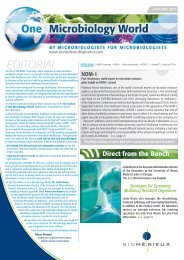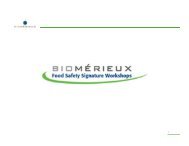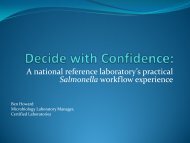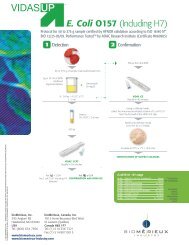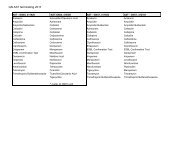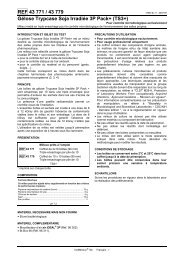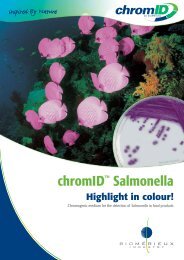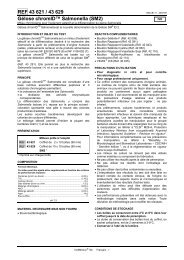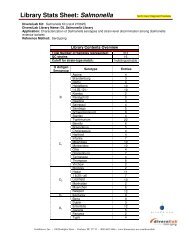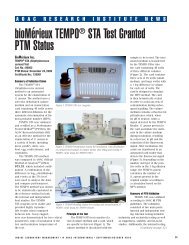Control of Listeria in Processing Plants - bioMérieux
Control of Listeria in Processing Plants - bioMérieux
Control of Listeria in Processing Plants - bioMérieux
Create successful ePaper yourself
Turn your PDF publications into a flip-book with our unique Google optimized e-Paper software.
<strong>Control</strong> <strong>of</strong> <strong>Listeria</strong> <strong>in</strong> Process<strong>in</strong>g <strong>Plants</strong>bioMérieux’s Food Safety Signature WorkshopWendy McMahon, Silliker, Inc.Plant Hollywood Resort & Cas<strong>in</strong>oSeptember 29, 2012
Significance <strong>of</strong> <strong>Listeria</strong> monocytogenesPsychrotroph• Multiplies at refrigeration temperaturesListeriosis• High fatality rate rang<strong>in</strong>g from 20% - 30%• High risk populations• Pregnant women• Immuno-compromised• Elderly• Manifestations• Septicemia, Men<strong>in</strong>gitis, Encephalitis, Intrauter<strong>in</strong>e or cervical <strong>in</strong>fections <strong>in</strong>pregnant women (results <strong>in</strong> spontaneous abortion or stillbirth)• Gastro<strong>in</strong>test<strong>in</strong>al or <strong>in</strong>fluenza-like symptoms such as nausea, vomit<strong>in</strong>g,diarrhea and fever may precede more serious forms <strong>of</strong> listeriosis or may bethe only expressed symptom.http://www.fda.gov/downloads/Food/FoodSafety/FoodborneIllness/FoodborneIllnessFoodbornePathogensNaturalTox<strong>in</strong>s/BadBugBook/UCM297627.pdf
Significance <strong>of</strong> <strong>Listeria</strong> monocytogenesReady-to-Eat refrigerated foods considered high risk• Ability to grow at refrigerated temperatures• Coupled with high fatality rateConsumer protection depends on prevent<strong>in</strong>gcontam<strong>in</strong>ation <strong>in</strong> those foods <strong>in</strong> which growth can occur• Intervention strategies• <strong>Control</strong> measures
Top Reasons for FDA Recalls - 2011Quality7%Mislabeled20%Microbial30%Sulfites3%Heavy metals2%Ex mat3%Undeclaredallergens35%
Reasons for FSIS Recalls - 2011Ex Mat5%E. coli O157:H712%Residue1%Misbrand<strong>in</strong>g8%Undeclaredallergen38%Other13%<strong>Listeria</strong>monocytogenes11%Salmonella10%Process<strong>in</strong>gdefect2%
<strong>Listeria</strong> monocytogenes (Lm) ProductRecalls <strong>in</strong> the United States, 2006-2007Food Product Total #Prepared foods 32Fish, seafood products 27Meat & poultry products 23Dairy products 7Fruits, vegetables 2Grand Total 91*Most <strong>of</strong> these recalls resulted from post-process contam<strong>in</strong>ation6
Food Recalls – <strong>Listeria</strong> monocytogenes2011FDA and FSIS Recalls Due to <strong>Listeria</strong> - 2011Meat/Poultry20%Dairy25%Fruit or Vegetable22%Prepared foods11%Spices2%Seafood20%7
The Value <strong>of</strong> a <strong>Listeria</strong> sp. EnvironmentalMonitor<strong>in</strong>g ProgramMany recalls <strong>of</strong> f<strong>in</strong>ished product are due to the presence <strong>of</strong> <strong>Listeria</strong>monocytogenes result<strong>in</strong>g from post-process contam<strong>in</strong>ation.Environmental monitor<strong>in</strong>g for <strong>Listeria</strong> species can identify growthniches and transfer po<strong>in</strong>ts.Corrective actions to elim<strong>in</strong>ate or control identified sites candramatically reduce the risk <strong>of</strong> L. monocytogenes contam<strong>in</strong>ation.Use <strong>of</strong> test<strong>in</strong>g to identify, monitor and control is an important toolfor prevent<strong>in</strong>g contam<strong>in</strong>ation.8
Critical Aspects <strong>of</strong> Prevent<strong>in</strong>g Post ProcessContam<strong>in</strong>ationPrevent the <strong>in</strong>troduction <strong>of</strong> (Lm) <strong>in</strong>to the post process environment.Prevent growth <strong>of</strong> (Lm) <strong>in</strong> the post process environment.Prevent distribution <strong>of</strong> (Lm) from contam<strong>in</strong>ated areas to productcontact areas.9
The Ideal Food Plant LayoutRawMaterialRawProcess<strong>in</strong>gAreaKillStepPackag<strong>in</strong>gAreaShipp<strong>in</strong>gNote: Same issues apply to food preparation <strong>in</strong>homes and foods service operations10
Microbial Mapp<strong>in</strong>g <strong>of</strong> the Plant Environment“Mapp<strong>in</strong>g” is a microbial survey <strong>of</strong> a plant environment.Identify equipment and plant environment locations for sampl<strong>in</strong>g.Use “zone concept”.Sample all sites several times before start<strong>in</strong>g environmentalmonitor<strong>in</strong>g program to elim<strong>in</strong>ate orig<strong>in</strong>al contam<strong>in</strong>ation and getenvironment under control.11
Sanitary ZonesZone 1Zone 2Zone 3Zone 4Food Contact Surfaces (FCS)- slicers, conveyors, peelers, striptables, utensils, racks, work tablesNon FCS-Exterior <strong>of</strong> equipment; chill units; framework;equipment hous<strong>in</strong>g, floorsNon FCS-Phones; mules; forklifts; walls; dra<strong>in</strong>sRemote areas–Non FCS-Locker rooms, cafeteria, halls
Sanitary ZonesZone 1Zone 2Zone 3Zone 4
Requirements for Microbial GrowthMicrobialGrowth NicheFoodContam<strong>in</strong>ationWaterTime
Growth NichesLocations harbor<strong>in</strong>g the organism after the rout<strong>in</strong>e sanitationprocess for that area has been completed.Example– Hollow roller on conveyortransport<strong>in</strong>g food productHollow rollers not disassembledcleaned and sanitized orheat treated <strong>in</strong> a manner toelim<strong>in</strong>ate any contam<strong>in</strong>at<strong>in</strong>gorganisms can becomegrowth niches.
Growth NichesHollow roller with solid sta<strong>in</strong>less steelshaft <strong>in</strong> center (almost press fit).When center shaft removed organicmatter is evident.
Transfer Po<strong>in</strong>ts vs NichesMany positive sites found dur<strong>in</strong>g monitor<strong>in</strong>g are not growthniches. They are transfer po<strong>in</strong>ts (i.e., a product handler’sgloved hands, floor sample <strong>in</strong> high traffic pathway).Transfer po<strong>in</strong>ts are not growth nichesbecause the organism is elim<strong>in</strong>ated dur<strong>in</strong>gthe clean<strong>in</strong>g and sanitiz<strong>in</strong>g process.
Environmental Monitor<strong>in</strong>g for Niches andTransfer Po<strong>in</strong>tsMonitor<strong>in</strong>g for <strong>Listeria</strong> sp.• Rationale is that <strong>Listeria</strong> species survive and grow under similarconditions to L. monocytogenes.• <strong>Listeria</strong> sp. are more prevalent than L. monocytogenes.• Therefore, they are a good <strong>in</strong>dicator <strong>of</strong> conditions that mightharbor or allow growth <strong>of</strong> L. monocytogenes.Objective <strong>of</strong> environmental sampl<strong>in</strong>g is to identifyniches and transfer po<strong>in</strong>ts.Allow<strong>in</strong>g corrective actions to be implemented.
% PositiveSurveillance <strong>of</strong> <strong>Listeria</strong> <strong>in</strong> Process<strong>in</strong>g Plant302520Floors151050Packag<strong>in</strong>g L<strong>in</strong>esDec Jun Dec Jun Dec Jun Dec Jun1989 1990 1991 1992From: R.B. Tompk<strong>in</strong>
Use <strong>of</strong> Sub-Typ<strong>in</strong>g as a ToolMolecular subtyp<strong>in</strong>g method• Generates a DNA f<strong>in</strong>gerpr<strong>in</strong>t• Discrim<strong>in</strong>ation at the species, subspecies, or stra<strong>in</strong> level• Allows for stra<strong>in</strong>-to-stra<strong>in</strong> comparisonUses <strong>in</strong> the food <strong>in</strong>dustry• Microbial source and spread track<strong>in</strong>g• Compare stra<strong>in</strong>s at different locations with<strong>in</strong> a plant• Compare environmental isolate to f<strong>in</strong>ished product isolate• Niche identification
Use <strong>of</strong> Sub-Typ<strong>in</strong>g as a ToolPulsed-Field Gel Electrophoresis (PFGE)• Reproducibility• Ability to centralize and exchange typ<strong>in</strong>g data• Standardized and <strong>in</strong>tegrated (PulseNet, CDC)Repetitive element sequence-based PCR (rep-PCR)• Non-cod<strong>in</strong>g repetitive sequences found <strong>in</strong>terspersed throughoutbacterial and fungal genomes• Rep elements found <strong>in</strong> all bacteria and fungi studied to date
Example <strong>of</strong> Use <strong>of</strong> Sub-Typ<strong>in</strong>g for Trac<strong>in</strong>g<strong>Listeria</strong> Contam<strong>in</strong>ationObjective <strong>of</strong> the study• Evaluate the discrim<strong>in</strong>atory capacity <strong>of</strong> PFGE and rep-PCR to be ableto use for trac<strong>in</strong>g and track<strong>in</strong>g <strong>Listeria</strong> contam<strong>in</strong>ationCold smoked salmon production plant• 3 year study <strong>of</strong> Company A and Company B• Company A relocated to Company B <strong>in</strong> 3 rd yearKey f<strong>in</strong>d<strong>in</strong>gs• A specific <strong>Listeria</strong> sub-type was established before the move andfound after relocation• Environmental isolates were traced to f<strong>in</strong>ished product for Company A• Isolates from raw product were traced to semi-f<strong>in</strong>ished product(Company B)Sub-typ<strong>in</strong>g can be used to determ<strong>in</strong>e contam<strong>in</strong>ation routesM. ZUNABOVIC, et al, JFP Vol 75 No 3, 2012; “Monitor<strong>in</strong>g Transmission Routes <strong>of</strong> <strong>Listeria</strong> spp. <strong>in</strong> SmokedSalmon Production with Repetitive Element Sequence-Based PCR Techniques”.
SummaryMany recalls due to L. monocytogenes result from post-processcontam<strong>in</strong>ation.Environmental monitor<strong>in</strong>g for <strong>Listeria</strong> species can identify growthniches and transfer po<strong>in</strong>ts.• Sub-typ<strong>in</strong>g can be a tool to traceCorrective actions to elim<strong>in</strong>ate or control identified sites candramatically reduce the risk <strong>of</strong> L. monocytogenes contam<strong>in</strong>ation.
One more th<strong>in</strong>g125 g test portion sizes for USDA samples
Thank you!



